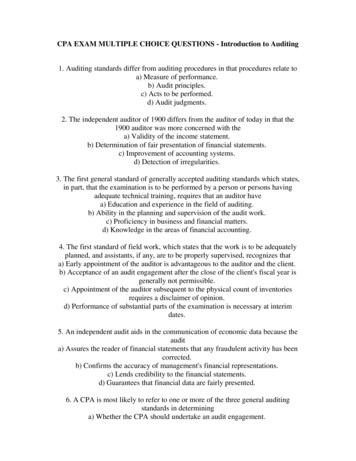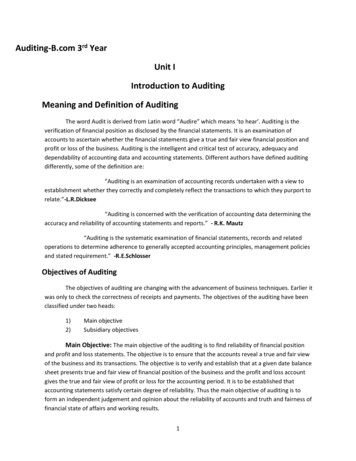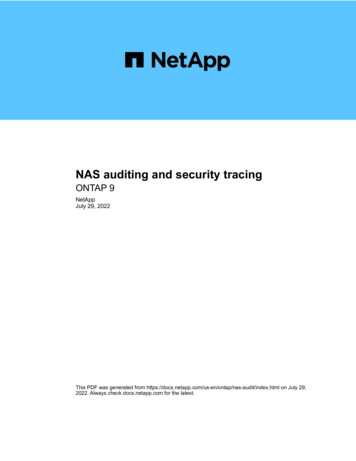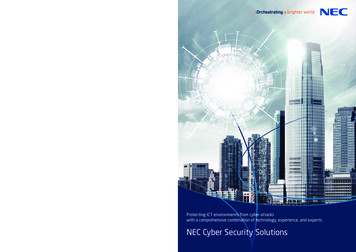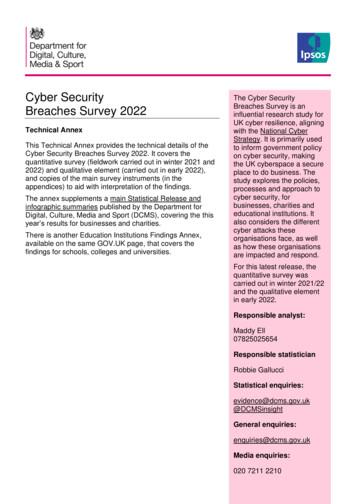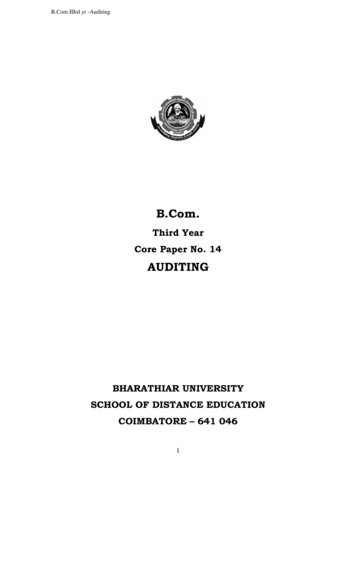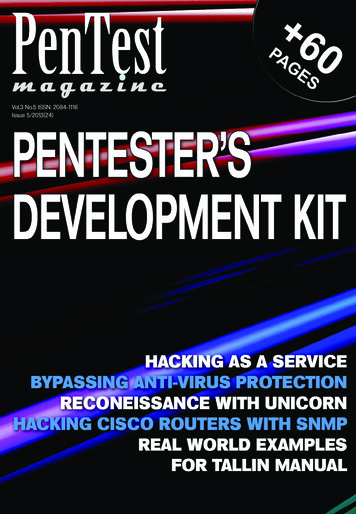
Transcription
Cyber Security Auditing SoftwareImprove yourFirewall AuditingAs a penetration tester you have to be an expert in multipletechnologies. Typically you are auditing systems installed andmaintained by experienced people, often protective of their ownmethods and technologies. On any particular assessment testers mayhave to perform an analysis of Windows systems, UNIX systems, webapplications, databases, wireless networking and a variety of networkprotocols and firewall devices. Any security issues identified withinthose technologies will then have to be explained in a way that bothmanagement and system maintainers can understand.he network scanning phase of apenetration assessment will quicklyidentify a number of securityweaknesses and services running on thescanned systems. This enables a tester toquickly focus on potentially vulnerablesystems and services using a variety of toolsthat are designed to probe and examinethem in more detail e.g. web service querytools. However this is only part of the pictureand a more thorough analysis of mostsystems will involve having administrativeaccess in order to examine in detail howthey have been configured. In the case offirewalls, switches, routers and otherinfrastructure devices this could meanmanually reviewing the configuration filessaved from a wide variety of devices.Although various tools exist that canexamine some elements of a configuration,the assessment would typically end upbeing a largely manual process. NipperStudio is a tool that enables penetrationtesters, and non-security professionals, toquickly perform a detailed analysis ofnetwork infrastructure devices. NipperStudio does this by examining the actualconfiguration of the device, enabling a muchmore comprehensive and precise audit thana scanner could ever achieve.www.titania.com
With Nipper Studio penetration testers can be experts inevery device that the software supports, giving them theability to identify device, version and configurationspecific issues without having to manually referencemultiple sources of information. With support for around100 firewalls, routers, switches and other infrastructuredevices, you can speed up the audit process withoutcompromising the detail.You can customize the audit policy for your customer’sspecific requirements (e.g. password policy), audit thedevice to that policy and then create the report detailingthe issues identified. The reports can include devicespecific mitigation actions and be customized with yourown companies styling. Each report can then be savedin a variety of formats for management of the issues.Why not see for yourself, evaluate forfree at titania.comIan has been working with leading globalorganizations and government agencies tohelp improve computer security for morethan a decade.He has been accredited by CESG for his security andteam leading expertise for over 5 years. In 2009 IanWhiting founded Titania with the aim of producingsecurity auditing software products that can be used bynon-security specialists and provide the detailedanalysis that traditionally only an experiencedpenetration tester could achieve. Today Titania’sproducts are used in over 40 countries by s,telecommunications companies, national infrastructureorganizations and auditing companies, to help themsecure critical systems.www.titania.com
Dear Readers,e have a pleasure to present you the newest isWsue of PenTest Regular. The ‘Pentester’s Development Kit’ will allow you to take your penetrationtesting skills to the next level. This month, you will encounter ten articles which will give you a wide scopeof techinques and tools and will definitely help you inyour career.Editor in Chief: Ewa Durancewa.duranc@pentestmag.comManaging Editor:Zbigniew Fiołnazbigniew.fiolna@pentestmag.comJakub Walczakjakub.walczak@pentestmag.comEditorial Advisory Board: Jeff Weaver, Rebecca WynnBetatesters & Proofreaders: Ayo Tayo Balogun, Aidan Carty,Gregory Chrysanthou, Amit Chugh, Dan Dieterle, Pilo Dx, PintoElia, Mardian Gunawan, Steve Hodge, David Jardin, LaneyKehel, Gilles Lami, L. Motz, Phil Patrick, Sagar Rahalkar, IñakiRodriguez, Tim Singletary, Jeff Smith, Steven WierckxSpecial Thanks to the Beta testers and Proofreaders whohelped us with this issue. Without their assistance there wouldnot be a PenTest magazine.Senior Consultant/Publisher: Pawel MarciniakCEO: Ewa Dudzicewa.dudzic@pentestmag.comProduction Director: Andrzej Kucaandrzej.kuca@pentestmag.comDTP: Ireneusz PogroszewskiArt Director: Ireneusz blisher: Hakin9 Media Sp. z o.o. SK02-682 Warszawa, ul. Bokserska 1Phone: 1 917 338 3631www.pentestmag.comWhilst every effort has been made to ensure the high quality ofthe magazine, the editors make no warranty, express or implied,First, ‘Let’s Talk About Security’: Rob Muris andTrajce Dimkov will present you their concept of ‘Hacking as a Service’ and Lance Cleghorn will give youseveral real life situations, in which knowledge of theTallinn Manual comes in handy.In the ‘Techniques’ section you will be able to readwhat Noman Mohammed and Benjamin C. M. Funghave to say about ‘Privacy-Preserving Data Publishing’. After that, Fadli B. Sidek will instruct you onavoiding anti-virus and anti-spyware detection. Next,you will find ‘Phantom’s Cerebrum: Using Python toWork a Botnet’ by Milind Bhargava. And closing thissection, Mohsen Mostafa Jokar will explain how tocreate a cryptographic key with the GnuPG standard.The ‘Tools’ section will be opened by ChristopherAshby explaining to you ‘Automating Malware Analysis with Cuckoo’. The next tool will be an interestingalternative to nmap – unicorn explored by AleksandarBratic. Finally, the issue will be closed by Jason Nehrboss guiding you through entering a Cisco routerwith SNMP and Midnitesnake sharing his knowledgeof The USB Rubberducky – The Pentester’s USB.We hope that our authors’ hard work will allow youto improve your skills, what will result in your work being not so hard. As always, we did our best to bringyou the top quality content. Enjoy your reading!concerning the results of content usage.Jakub Walczak & the PenTest teamAll trade marks presented in the magazine were used only forinformative purposes.All rights to trade marks presented in the magazine arereserved by the companies which own them.DISCLAIMER!The techniques described in our articles may onlybe used in private, local networks. The editorshold no responsibility for misuse of the presentedtechniques or consequent data loss.05/2013 (24) AugustPage4http://pentestmag.com
CONTENTSLET’S TALK ABOUT SECURITY06Hacking as a ServiceBy Rob Muris and Trajce DimkovBy Mohsen Mostafa JokarTo gain insight into their security vulnerabilities, companiesperform penetration tests on their websites and infrastructure.Mostly, the tests are performed ad hoc or maybe on a yearlybasis. This is not sufficient due to the continuous change ofthe IT landscape and the new vulnerabilities discoveries. Thequestion that rises is: how can companies keep their securityexposure visible despite these changes? In this article, we focus on one possible answer to this: hacking as a service.10Interpreting the Tallinn Manual UsingReal World ExamplesPrivacy-Preserving Data PublishingBy Noman Mohammed and Benjamin C. M. FungPrivacy-preserving data publishing is an exciting research area. This article presents different technical proposals to thedemand of simultaneous information sharing and privacy protection. However, the problems of data privacy cannot be fullysolved only by technology. We believe that there is an urgentneed to bridge the gap between advanced privacy preservation technology and current policies.Evasion: Bypassing AV Products24AVand Protection Against ItBy Fadli B. SidekAV evading techniques are getting better and smarter by theday, and having just an Anti-Virus and Anti-Spyware application is insufficient to protect our machines from additional angles of threats.Phantom’s Cerebrum: Using Pythonto Work a BotnetBy Milind BhargavaImagine a ghost robot in every computer, working in the shadows; let’s call it the Phantom, performing tasks for its master.The master controls the ghosts through a master brain device; let’s call it the cerebrum, much like the device Prof Xavier had in the X-Men. That device could control the minds ofmutants all over the world. In this case, the cerebrum controlsthe phantoms in each computer of my home and workplace.05/2013 (24) AugustTOOLSMalware Analysis with44AutomatingCuckooThis article will outline implementing an automated virtual environment to aid in the identification and analysis of potentiallymalicious software, what can then be extended to proactivelydetect and ultimately protect corporate environments from being infected.Magic Help in50UnicornReconnaissanceBy Aleksandar BraticTECHNIQUES28Cryptography is used to decode an important message. Thereceiver takes a ciphered message and uses a key for converting it to a comprehensible one. There are many reasons toperform cryptography: a messenger may be captured by theenemy or even deliver the message to the wrong person. Ifthe message was in plaintext or cleartext, anybody could readand understand it.By Christopher AshbyBy Lance CleghornThe Tallinn Manual on the International Law Applicable to CyberWarfare was published in 2013 and is the result of three years ofresearch by twenty of the world’s top legal and technical scholars. The Tallinn Manual is an effort of the NATO CooperativeCyber Defense Centre of Excellence that began in 2009. Theprimary goal of this effort is to create a manual of the highestprofessional integrity, which could be referenced in the event thatthe subject matter was to ever reach the international spotlight.1636Cryptography with GPGPageThe first and critical phase of testing is reconnaissance wherewe usually rely on nmap, which is the most famous, and thebest tool (or one of the best ones). Recently, I have started touse unicorn to complete my reconnaissance phase and I havefound several very useful options of this tool. These optionswill be explained in this article.54Hacking Cisco Routers with SNMP60The USB Rubber Ducky– The Pentesters’ USBBy Jason NehrbossCisco routers have a number of remote access and management services available. One of the most used and least insecure is SNMP. The article shows some of the common techniques and demonstrates a new tool for taking over routersthat are vulnerable. Virtually all networking devices supportSNMP, and most network monitoring and management software uses it.By MidnitesnakeThe USB Rubber Ducky or ‘Ducky,’ for short, is a programmable Human Interface Device (HID), that, when inserted into anOperating System (OS), will interact or assume the identity ofa certain device: keyboard, mass storage, or a given combination, allowing the injection of keystrokes or applications intothe OS’s memory. The key focus on the Ducky is that it can beprogrammed in a simple high-level language that any user ofany technical skill level can quickly and easily learn to program.5http://pentestmag.com
LET'S TALK ABOUT SECURITYHacking as a ServiceTo gain insight into their security vulnerabilities, companiesperform penetration tests on their websites and infrastructure.Mostly, the tests are performed ad hoc or maybe on a yearlybasis. This is not sufficient due to the continuous change of the ITlandscape and the new vulnerabilities discoveries. The questionthat rises is: How can companies keep their security exposurevisible despite these changes? In this article, we focus on onepossible answer to this: Hacking as a Service.Attacks on websites and online applicationstake place every day and precious businessinformation is leaking away. An organizationcan understand the exposure from such attacks byexecuting penetration tests.Penetration tests are done usually ad hoc. Thereare three reasons why ad hoc testing is not sufficient.First, hackers constantly find and use newly discovered vulnerabilities. Second, organizations constantly move through new initiatives (BYOD, The Cloudetc.) and changes on the existing infrastructure andapplications (updates/upgrade or adjustments toconfiguration etc.), what often leads to bringing newsystems or services online. Third, periodic penetration tests are widely accepted as security ‘best practice’ and are required by many regulatory standards,including the PCI Data Security Standard, but also local laws like the Dutch privacy act. To keep the expo-sure of the organization visible, up-to-date, and compliant with regulations, periodic penetration testing isneeded. ‘Hacking as a Service’(HaaS), is a service inwhich a third party periodically tests the online environment for security issues, compares the differencein the results from previous tests and gives the clientan up-to-date insight in its exposure.In this article we describe some key elements ofHacking as a Service, how it works and the dynamic way of vulnerability reporting.In 2011 the Sony PlayStation Network (PSN) gothacked. Millions of user accounts were affected, thePSN had to be taken down and payment card detailswere stolen. A few months later, Sony’s CIO stated thatthe attack on the PSN was based on a ‘known vulnerability’.This is one example that shows how important itis to have an up-to-date insight in existing vulnerabilities and to act on, before someone else abuses them.The infrastructure and applications are tested forvulnerabilities on a periodic basis. Thus, client isnot dependent on the results of a one-time test buton a range of tests executed over time.05/2013 (24) AugustWhat is Hacking as a Service?With HaaS client takes a subscription to hacking.Instead of executing penetration tests ad hoc, client gets periodic penetration testing and gets upto-date insight in their security information. Thekey elements of this service are:Testing on periodic basisDiscovery of trends via testing resultsAccumulated test results from a long period of timeprovide an insight into trends for a specific systemor the whole infrastructure. These trends can bePage 6http://pentestmag.com
used to give an overview to senior managementon how much the external exposure has changedover time. Senior management can use such analysis to define budgeting and expected amount ofimprovement for the coming year.Faster insight in the presence of newvulnerabilitiesHaving frequent penetration tests enables companyto have a clear up-to date overview of the currentvulnerabilities on their infrastructure and externallyfacing applications. When new software vulnerability emerges it is required to reduce its impact. Having a clear overview of the used software versionenables targeted penetration tests that can be executed in order to directly test whether a new vulnerability is applicable to the systems of the companyand whether the existing security controls are sufficient to reduce or compensate the impact.Ensuring that the security controls do notdegrade over timeWith change, security controls get more relaxed andin some cases disabled. Periodic penetration testing helps to identify the change of the security controls over time. HaaS enables management to checkwhether vulnerabilities found in previous penetration tests were remedied, and whether the newly deployed controls are sufficient to mitigate the risk. Therequirement for offering a service like HaaS. Offeringa service like HaaS requires the setup and development of a number of components, such as: Penetration testing environment;Automated tools;Standardized output files;Test scripts.gies. Therefore, the service provider needs to havea structured way to implement these new tools andmethodologies in the penetration testing environment and keep in mind that previous results needto be comparable with new testing results.Automating tools is not enough. Almost every toolreports false positives that need to be filtered out.Also, tools cannot find all the vulnerabilities. Therefore, the service provider needs to perform additional manual testing. Since every pentester has hisown way of testing, the service provider needs tofind a way to perform the additional manual testingin a consistent and secure way. A way to do this isto make use of test scripts. Using a test script allowsthe service provider to document what a pentester can do, how can he execute the tasks, how theresults are documented, and what preventive measurements for issues and outages should be taken.If the service provider does not perform the additional manual testing in a consistent way, he cannotcompare the results from multiple tests.Automation of tools and creation of standard output files can be used for reporting. These outputfiles are used to import the results into a report or asecurity dashboard used for reporting. These canthen provide granular and historical information onthe existing systems and their vulnerabilities.Setting up the above components can be challenging and costly (for example, the automationof tools, writing the test scripts, installing and configuring the penetration testing environment, andstandardized update of the tools), but it will enableevery tester to use the same approach and thesame tools. As a result, the penetration tests willOverview latest security tests161412Organization that offers the service (service provider) needs a highly secured penetration testing environment which includes the preferred penetrationtesting tools, such as Nmap, Dirbuster, Nexpose,Wireshark and Nessus. The penetration testingenvironment should be used to automate as many tasks as possible to consistently use the toolsto detect hosts, perform port scans and vulnerability scanning on infrastructure and application. Thisallows comparison of results between the tests andenables the client to determine the progress madein remedying the identified risks. The penetrationtesting environment may change also because ofthe changes of the threat landscape or the releaseof new penetration testing tools and methodolo05/2013 (24) AugustLowMediumHigh1086420Security test 1Security test 2Security test 3Security test 4Open and closed ure 1. Number of charts showing the risk exposure of theorganization over timePage 7http://pentestmag.com
LET'S TALK ABOUT SECURITYbe executed in a consistent, accurate, and efficientway and will enable presenting the results in structured and consistent manner.The dynamic way of vulnerabilityreportingThe main goal of vulnerability reporting is to makeclient aware of the vulnerabilities. By using theHaaS approach, organizations can stop using thestatic penetration test reports and transit to a solution that facilitates the dynamic and clear way of reporting. For instance, a security dashboard, like theone presented in Figure 1, could support the organization in getting actual insight on its risk exposure.The security dashboard could then be used as agraphical management summary for all tests thathave been performed. It contains informationalcharts about the latest test and gives insight intomultiple tests as well. The dashboard should also contain the technical details for the IT department. Combining this information in one centralized place, makes it possible for the managementand the IT to discuss the same problems. Figure2 contains information that normally should be ina penetration test report. The advantage of usinga dynamic form of reporting is the possibility to filter on, for example, the highest risks. In short: asecurity dashboard could support organizations ingetting actual insight into their online security level.Getting into action with vulnerabilitytrackingAside from vulnerability reporting, it is also important to get vulnerabilities addressed. However, theremediation should be done by a separate party,so that independence of the penetration testerscan be maintained. Consider this scenario: Theservice provider performed a penetration test anddelivered to the client the report with detailed information about the observations. After a certain time,the service provider performed the same penetration test with the same scope again and the samevulnerabilities showed up.Frequently, client reads the report but no furtheractions are taken. The report is then put in an archive, sometimes some of the vulnerabilities arefixed and the other ones get forgotten over time.The main reason why vulnerabilities are not addressed properly, is because nobody has takenthe responsibility for fixing them or the follow-upactions are not tracked. That is the reason whyvulnerability tracking is needed. The vulnerabilitytracking module has some critical success factors:The possibility to assign responsibilityIf nobody is responsible, nobody will act. Therefore, all the new vulnerabilities should be assignedto a specific person responsible for remedying thevulnerability.Figure 2. Detailed observation description for ITFigure 3. Vulnerability tracking05/2013 (24) AugustPage 8http://pentestmag.com
The possibility to assign prioritiessimulates an attack by a malicious attacker onthe infrastructure and website, and an attack by amalicious attacker who already got access to theonline applications in the organization.It is important to assign a priority to each of the vulnerabilities. The priority will inform the assignee inwhich sequence the vulnerabilities need to be fixed.The possibility to monitor the progressFor all vulnerabilities, the manager must be able todetermine the current state. Based on the state theclient can determine if extra actions are needed.With vulnerability tracking between penetrationtests the organization can manage the process offixing vulnerabilities from one central place. Thiscan be done through a security dashboard, wherea manager can monitor in the real time all the follow-up actions for the vulnerabilities of the performed penetration tests. When a new vulnerabilityis found, the client can address those vulnerabilitiesand make someone responsible for fixing the vulnerability. Afterwards, the client can track the effortsmade by the assignee to fix the vulnerability. Therefore, vulnerability tracking helps the client increasethe vulnerability fixing capabilities (see Figure 3).Different client, different needsEvery client is different and has specific needswhat is reflected in the scope of the penetrationtests. In case of HaaS, these needs can be localized in different testing levels, such as infrastructure, web application, and advanced web application. Here are the levels examples: The infrastructure level is the starting level,where the company gets a periodic penetrationtesting of Internet-facing infrastructure components and the presence of new systems. The second level is web application (which includes the infrastructure level), providing more indepth tests of the website, such as SQL injectionand Cross-Site Scripting (XSS). With this test,the organization simulates an attack by a malicious attacker on the infrastructure and website. The third level is advanced web application, including thorough penetration testing of web applications, specifically on ‘privilege escalation’ (theunauthorized access to information or functionsas a normal user). With this test the organizationThe advantage of HaaS is that the tests can beperformed daily, monthly, quarterly or every sixmonths, for each of the testing levels. Since theinfrastructure of penetration testing is set for a periodic testing, the organization can have additionaltesting when needed (for example after performing any changes) with a minimal overhead.ConclusionIn the past, multiple companies were hacked viaknown vulnerabilities. Some of the hacks couldhave been prevented if the companies had beenaware of their online risk exposure and if the actionshad been taken to remedy these vulnerabilities.Getting insight into client’s current vulnerabilitylevel can be achieved by performing a penetrationtest. Penetration test is a snapshot of the securityexposure of the organization, but it does not provide up-to-date information in a consistent manner.HaaS is a new service in penetration testing that attempts to cover this deficiency of traditional penetration tests. With HaaS, client gets periodic, consistentoverview of his security posture. Such overviews enables the client to identify emerging risks and followthe mitigation of the previously identified risks.ROB MURISTRAJCE DIMKOVFigure 4. Prioritization of remediation activities05/2013 (24) AugustRob Muris is a security consultant inthe Security & Privacy Team of Deloitte Netherlands. He is involved inthe development of Hacking as a Service and performs penetration testingassignments for various clients.Page 9Trajce Dimkov has obtained a PhD in Information Security with focus on physical penetration and social engineeringmethodologies. With over 6 years of experience, Trajce is a part of the Security& Privacy Team of Deloitte Netherlands,where he is involved in a number of penetration testing assignments.http://pentestmag.com
LET'S TALK ABOUT SECURITYInterpreting theTallinn Manual UsingReal World ExamplesThe Tallinn Manual on the International Law Applicable to CyberWarfare was published in 2013 and is the result of three years ofresearch by twenty of the world’s top legal and technical scholars[12]. The Tallinn Manual is an effort of the NATO Cooperative CyberDefense Centre of Excellence that began in 2009 [12].The primary goal of this effort is to create amanual of the highest professional integrity, which could be referenced in the eventthat the subject matter were to ever reach the international spotlight [12]. The authors of the TallinnManual had to consider every scenario relating tocyber warfare and attempt to predict how the cyberbattlefield may change in years to come.The Tallinn manual categorizes the appropriateresponses to a certain level of engagement of cyber operations crossing international boarders orsponsored by a nation. The manual is organizedinto 95 rules that serve to determine if an incidentmeets the standards for aggression and define theappropriate response [12]. The 300-page document is strongly backed by international precedence and treaty laws respected by NATO membernations [12]. The authors aimed for a high degreeof specificity to avoid pitfalls that could stem frommisinterpretation.While there is no treaty that requires nations torespect the Tallinn Manual’s guidelines, if an incident were to occur, the manual could be usedas justification for retaliation. The Tallinn Manualcould also be used to condemn a nation for mishandling a situation. The authors had to evalu05/2013 (24) Augustate the implications of their work and try to comeup with a neutral set of suggestions that the international community could agree on. To aid inthe understanding of this endeavor, it is best toanalyze it through the evaluation of real-worldscenarios where documented advanced persistent threats may eventually be linked to the efforts of a nation state. While the Tallinn Manualspecifically states that as of its publication, noprior attack has met the criteria of a cyber-attackthat would trigger an armed conflict status, thisarticle will see how close some advanced persistent threats have come to this classificationand what hypotheticals could have escalated theevents [12].The category of a cyber-incident is important tobe determined prior to taking any action. The useof force, or the ability to respond with kinetic warfare, is reserved for scenarios where an armedconflict is apparent [12]. The authors of the Tallinn Manual concluded unanimously that a cyberattack could constitute the initiation of an armedconflict as long as the perpetrators were statesponsored and the resultant damage was consistent with a comparable physical assault (Rule 13Section 14 and 3-6) [12]. The armed conflict sta-Page 10http://pentestmag.com
tus is of importance because it triggers a nation’sinherent right to self-defense (Rule 15) [12].Advanced Persistent ThreatsIn recent years a subtle trend of cyber-attacksbegan to emerge that were categorized as advanced persistent threats [5]. To be classified asan advanced persistent threat, an attack has tomeet a majority of the criteria determined by thesecurity community to constitute such an attack[9]. While there are conflicting definitions of whatcriteria are included in an advanced persistentthreat, many experts agree that the threat agentmust possess limitless resources and be able tospend an excessive amount of time exploiting atarget [5, 9]. Another element that is alarminglycommon in advanced persistent threats is theability of the threat agent to incorporate zero-dayexploits into the attack [8].A zero-day exploit is one that has never beenseen before it is executed. These types of exploitsare difficult to uncover and often require the skillsof seasoned researchers. In the case of some advanced persistent threats, the malware used maycontain several zero-day exploits [8]. The ability ofa threat agent to incorporate zero-day exploits intoan attack can be a key indicator of an advancedpersistent threat [9].Case Study One:RSA and Lockheed MartinIn 2011 Lockheed Martin and several other major United States defense contractors reported attempted security breaches identified as part of anattack relating to the same advanced persistentthreat [14]. The threat agent utilized a zero-dayweakness in the RSA SecurID token to attemptto infiltrate the networks of the defense contractorvictims [10]. While the attack on the defense contractors was largely unsuccessful in exfiltratingproprietary and sensitive data, it was later confirmed that the most alarming compromise had already taken place [1]. The zero-day weakness inRSA’s SecurID token was later confirmed by RSAto have been traceable to a previous attack whereRSA had proprietary seed values for the tech
Cyber Security Auditing Software www.titania.com Improve your Firewall Auditing As a penetration tester you have to be an expert in multiple technologies. Typically you are auditing systems installed and maintained by experienced people, often protective of their own methods and technologies. On any particular assessment testers may


